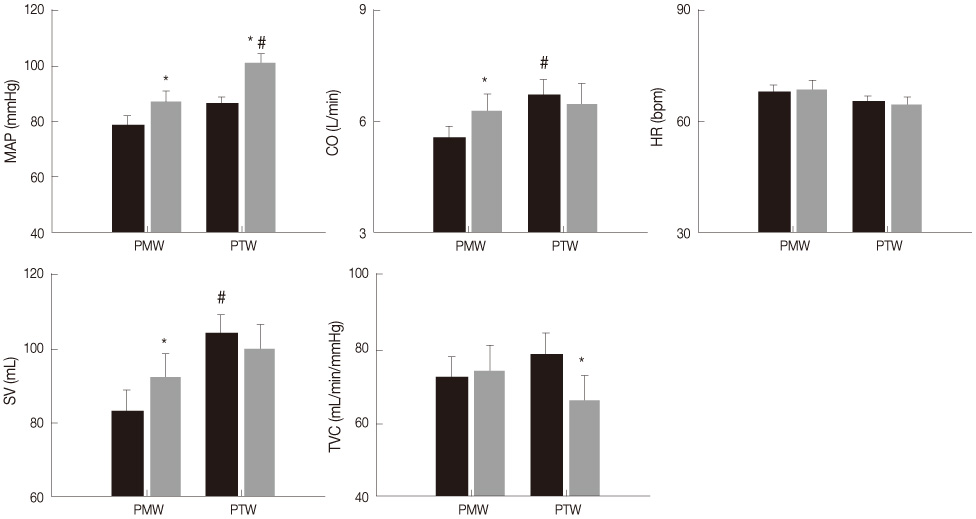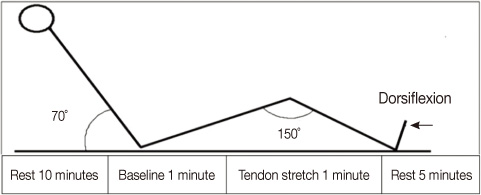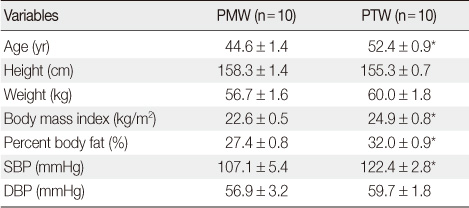Articles
- Page Path
- HOME > J Korean Acad Nurs > Volume 41(2); 2011 > Article
-
Original Article
- Estrogen Attenuates the Pressor Response Mediated by the Group III Mechanoreflex
- Seung-Ae Park, Jong-Kyung Kim
-
Journal of Korean Academy of Nursing 2011;41(2):191-196.
DOI: https://doi.org/10.4040/jkan.2011.41.2.191
Published online: April 30, 2011
1Doctoral Student, Graduate School of Physical Education, Kyung Hee University, Yongin, Korea.
2Assistant Professor, Graduate School of Physical Education, Kyung Hee University, Yongin, Korea.
- Address reprint requests to: Kim, Jong-Kyung. Graduate School of Physical Education, Kyung Hee University, 1 Seocheon-dong, Giheung-gu, Yongin 446-701, Korea. Tel: +82-31-201-2778, Fax: +82-31-201-3743, kyung19692002@khu.ac.kr
• Received: September 4, 2010 • Accepted: April 15, 2011
© 2011 Korean Society of Nursing Science
Abstract
-
Purpose
- We investigated the effects of group III mechanoreceptors to cardiovascular responses in both pre-menopausal woman and post-menopausal woman during passive ankle dorsiflexion (PAD).
-
Methods
- Twenty healthy volunteers (10 post-menopausal women and 10 pre-menopausal women) were recruited for this study. Stroke volume (SV), heart rate (HR), cardiac output (CO), and total vascular conductances (TVC) were measured continuously throughout the experiment. To stimulate the group III mechanoreceptors, PAD was performed for one minute.
-
Results
- The results showed that mean arterial pressure (MAP) mediated by the mechanoreflex activation was significantly increased in both groups. However, this pressor response was significantly higher in post-menopausal women. This reflex significantly increased both SV and CO in pre-menopausal women, while there were no differences in post-menopausal women. There was no difference in HR in either group. The mechanoreflex significantly decreased TVC in post-menopausal woman, while there was no difference in pre-menopausal woman.
-
Conclusion
- The results indicate that the excessive pressor response mediated by the mechanoreflex occurs due to overactivity of group III mechanorecptors and the mechanism is produced mainly via peripheral vasoconstriction in post-menopausal women.
- 1. Craig AD, Mense S. The distribution of afferent fibers from the gastrocnemius-soleus muscle in the dorsal horn of the cat as revealed by the transport of horseradish peroxidase. Neuroscience Letters. 1983;41:233–238.ArticlePubMed
- 2. Cui J, Blaha C, Moradkhan R, Gray KS, Sinoway LI. Muscle sympathetic nerve activity responses to dynamic passive stretch in humans. The Journal of Physiology. 2006;576:625–634.ArticlePubMedPMC
- 3. Ettinger S, Silber DH, Collins BG, Gray KS, Sutliff G, Whisler SK, et al. Influences of gender on sympathetic nerve responses to static exercise. Journal of Applied Physiology. 1996;80:245–251.ArticlePubMed
- 4. Ettinger SM, Silber DH, Gray KS, Smith MB, Yang QX, Kunselman AR, et al. Effects of the ovarian cycle on sympathetic neural outflow during static exercise. Journal of Applied Physiology. 1998;85:2075–2081.ArticlePubMed
- 5. Gladwell VF, Coote JH. Heart rate at the onset of muscle contraction and during passive muscle stretch in humans: A role for mechanoreceptors. Journal of Physiology. 2002;540:1095–1102.ArticlePubMedPMC
- 6. Hayes SG, Kaufman MP. Gadolinium attenuates exercise pre-ssor reflex in cats. American Journal of Physiology. Heart and Circulatory Physiology. 2001;280:H2153–H2161.ArticlePubMed
- 7. Hayes SG, Kindig AE, Kaufman MP. Comparison between the effect of static contraction and tendon stretch on the discharge of grup III and IV muscle afferents. Journal of Applied Physiology. 2005;99:1891–1896.ArticlePubMed
- 8. Hayes SG, Moya del Pino NB, Kaufman MP. Estrogen attenuates the cardiovascular and ventilatory responses to central command in cats. Journal of Applied Physiology. 2002;92:1635–1641.ArticlePubMed
- 9. Innes KE, Selfe TK, Taylor AG. Menopause, the metabolic syndrome, and mind-body therapies. Menopause. 2008;15:1005–1013.ArticlePubMedPMC
- 10. Kim JK, Augustyniak RA, Sala-Mercado JA, Hammond RL, Ansorge EJ, Rossi NF, et al. Heart failure alters the strength and mechanisms of arterial baroreflex pressor responses during dynamic exercise. American Journal of Physiology. Heart and Circulatory Physiology. 2004;287:H1682–H1688.ArticlePubMed
- 11. Kim JK, Hayes SG, Kindig AE, Kaufman MP. Thin-fiber mechanoreceptors reflexly increase renal sympathetic nerve activity during static contraction. American Journal of Physiology. Heart and Circulatory Physiology. 2007;292:H866–H873.ArticlePubMed
- 12. Koba S, Xing J, Sinoway LL, Li J. Differential sympathetic outflow elicited by active muscle in rats. American Journal of Physiology. Heart and Circulatory Physiology. 2007;293:H2335–H2343.ArticlePubMed
- 13. McCloskey DI, Mitchell JH. Reflex cardiovascular and respiratory responses originating in exercising muscle. Journal of Physiology. 1972;224:173–186.ArticlePubMedPMC
- 14. Pines A, Fisman EZ, Shapira I, Drory Y, Weiss A, Eckstein N, et al. Exercise echocardiography in post-menopausal hormone users with mild systemic hypertension. American Journal of Cardiology. 1996;78:1385–1389.ArticlePubMed
- 15. Rosano GMC, Sarrel PM, Poole-Wilson PA, Collins P. Beneficial effect of estrogen on exercise-induced myocardial ischemia in women with coronary artery disease. Lancet. 1993;342:133–136.PubMed
- 16. Schmitt PM, Kaufman MP. Estrogen attenuates the exercise pressor reflex in female cats. Journal of Applied Physiology. 2003;95:1418–1424.ArticlePubMed
- 17. Schmitt PM, Kaufman MP. Estrogens attenuating effect on the exercise pressor reflex is more opioid dependent in gonadally intact than in ovariectomized female cats. Journal of Applied Physiology. 2005;98:633–639.ArticlePubMed
- 18. Sinoway LI, Li J. A perspective on the muscle reflex: implications for congestive heart failure. Journal of Applied Physiology. 2005;99:5–22.ArticlePubMed
- 19. Smith SA, Mitchell JH, Garry MG. The mammalian exercise pressor reflex in health and disease. Experimental Physiology. 2006;91:89–102.ArticlePubMedPDF
- 20. Smith SA, Williams MA, Leal AK, Mitchell JH, Garry MG. Exercise pressor reflex function is altered in spontaneously hypertensive rats. The Journal of Physiology. 2006;577:1009–1020.ArticlePubMedPMC
- 21. Tsuchimochi H, Matsukawa K, Komine H, Murata J. Direct measurement of cardiac sympathetic efferent nerve activity during dynamic exercise. American Journal of Physiology. Heart and Circulatory Physiology. 2002;283:H1896–H1906.ArticlePubMed
- 22. Van Groningen LF, Adiyaman A, Elving L, Thien T, Lenders JW, Deinum J. Which physiological mechanism is responsible for the increase in blood pressure during leg crossing? Journal of Hypertension. 2008;26:433–437.ArticlePubMed
REFERENCES
Figure 2
Cardiovascular responses mediated by the mechanorefelx during foot ankle dorsiflexion.
Values are mean±standard error. PMW=Premenopausal woman; PTW=Postmenopausal woman; Black Bar: baseline; Gray Bar: mechanoreflex activation. *Significantly different from baseline value, p<.05; #Significantly different from PMW, p<.05; MAP=mean arterial pressure; HR=heart rate; SV=stroke volume; CO cardiac output; TVC=total vascular conductances.


Figure & Data
REFERENCES
Citations
Citations to this article as recorded by 

- Age-related alterations in the cardiovascular responses to acute exercise in males and females: role of the exercise pressor reflex
A. K. Grotle, J. V. Langlo, E. Holsbrekken, A. J. Stone, H. Tanaka, P. J. Fadel
Frontiers in Physiology.2023;[Epub] CrossRef - Influence of Age and Estradiol on Sympathetic Nerve Activity Responses to Exercise in Women
MEGAN M. WENNER, JODY L. GREANEY, EVAN L. MATTHEWS, SHANE MCGINTY, JASDEEP KAUR, WANPEN VONGPATANASIN, PAUL J. FADEL
Medicine & Science in Sports & Exercise.2022; 54(3): 408. CrossRef - Oral contraceptives and menstrual cycle influence autonomic reflex function
Elnaz Assadpour, Ilana Ivry, Sara Wasef, Baithat Adeyinka, Kevin R. Murray, Heather Edgell
Physiological Reports.2020;[Epub] CrossRef - Skeletal muscle metaboreflex is enhanced in postmenopausal women
Hyun-Min Choi, Charles L. Stebbins, Hosung Nho, Kyung-Ae Kim, Chanho Kim, Jong-Kyung Kim
European Journal of Applied Physiology.2012; 112(7): 2671. CrossRef
Estrogen Attenuates the Pressor Response Mediated by the Group III Mechanoreflex


Figure 1
Experimental foot ankle dorsiflexion
Figure 2
Cardiovascular responses mediated by the mechanorefelx during foot ankle dorsiflexion.
Values are mean±standard error. PMW=Premenopausal woman; PTW=Postmenopausal woman; Black Bar: baseline; Gray Bar: mechanoreflex activation. *Significantly different from baseline value, p<.05; #Significantly different from PMW, p<.05; MAP=mean arterial pressure; HR=heart rate; SV=stroke volume; CO cardiac output; TVC=total vascular conductances.
Figure 1
Figure 2
Estrogen Attenuates the Pressor Response Mediated by the Group III Mechanoreflex
Physical Characteristics of Participants
Values are mean±standard error.
*p<.05 vs. PMW.
PMW=premenopausal woman; PTW=postmenopausal woman; SBP=systolic blood pressure; DBP=diastolic blood pressure.
Table 1
Physical Characteristics of Participants
Values are mean±standard error. * PMW=premenopausal woman; PTW=postmenopausal woman; SBP=systolic blood pressure; DBP=diastolic blood pressure.
 KSNS
KSNS
 E-SUBMISSION
E-SUBMISSION


 Cite
Cite

